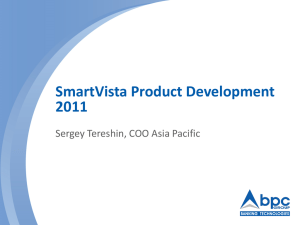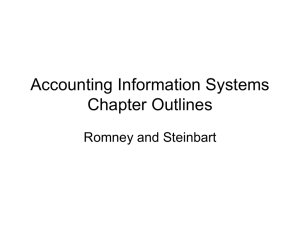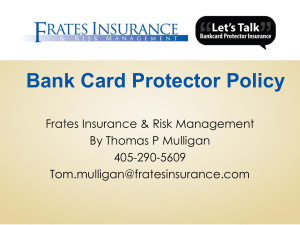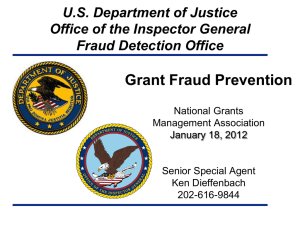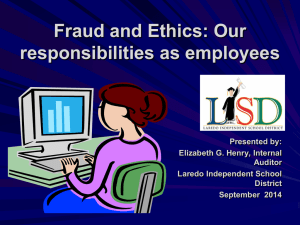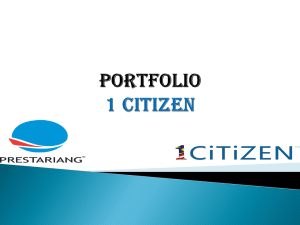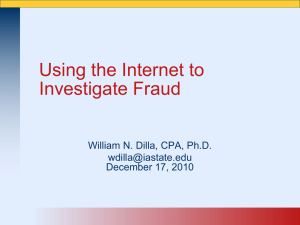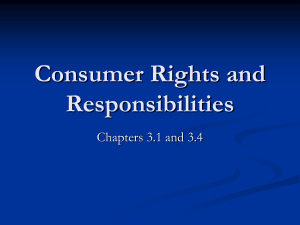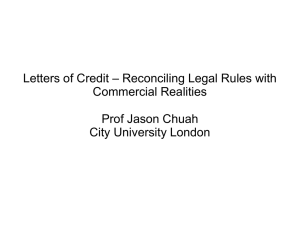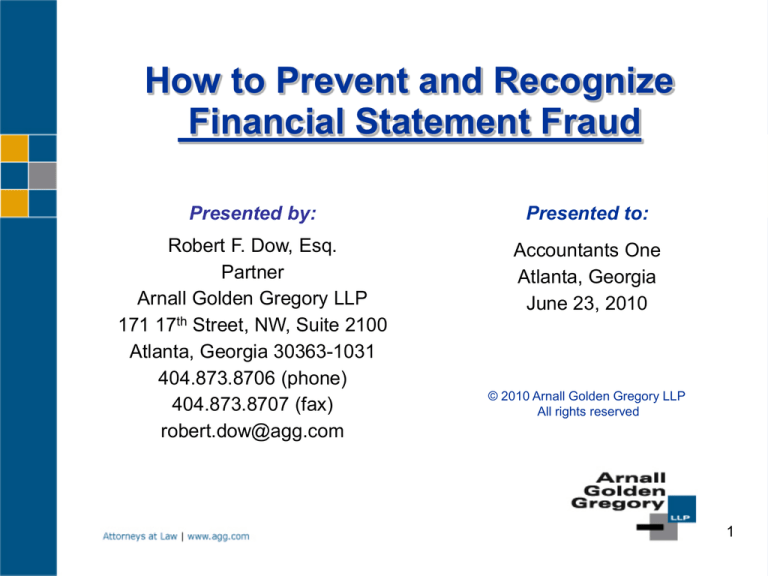
How to Prevent and Recognize
Financial Statement Fraud
Presented by:
Presented to:
Robert F. Dow, Esq.
Partner
Arnall Golden Gregory LLP
171 17th Street, NW, Suite 2100
Atlanta, Georgia 30363-1031
404.873.8706 (phone)
404.873.8707 (fax)
robert.dow@agg.com
Accountants One
Atlanta, Georgia
June 23, 2010
© 2010 Arnall Golden Gregory LLP
All rights reserved
1
Definition of Financial Statement Fraud
SAS 99 defines fraud as “an intentional act that
results in a material misstatement in financial
statements that are subject to audit.”
2
Key Ingredients for
Financial Statement Fraud
Financial statement fraud will not take place without
come combination of these ingredients:
• Someone, usually an executive, who will benefit
• Subordinates, accountants and others willing to
assist (“enablers”)
• Unalert gatekeepers (e.g., auditors; board of
directors)
3
A Key Question
Are you an Enabler? (i.e., One who assists another
in destructive behavior.)
4
ETHICS AND THE ART OF
ACCOUNTING
5
What is “Ethics”?
Webster’s definitions:
• Ethics “the principles of conduct governing an individual or
a group <professional ethics>”
• Profession: “a calling requiring specialized knowledge and
often long and intensive academic preparation”
• Are CPAs in industry members of a “profession”?
6
AICPA – Guidance
Professional Conduct
Principles
• Responsibilities
• Public Interest
• Integrity
• Objectivity and Independence
• Due Care
• Scope and Nature of Services
7
AICPA – Guidance
for CPAs in Industry
• Duty to external accountants
– Candid
– Full disclosure
• Subordination of judgment
– Failure to record transactions
– Misleading financial statements
• Ultimate solution to conflict: resign from the
company!
8
IFAC Code of Ethics
• International Federation of Accountants (IFAC)
• Code of Ethics for Professional Accountants
• Effective 6/1/06
• Separate section for “Professional Accountants in
Business”
9
IFAC Code of Ethics
(cont’d)
Fundamental Principles
• Integrity
• Objectivity
• Professional Competence and Due Care
• Confidentiality
• Professional Behavior
10
IFAC Code of Ethics
(cont’d)
Threats to Principles
• Self-interest
• Self-review
• Advocacy
• Familiarity
• Intimidation
11
Mark Twain on Ethics
“Always do right. This will
gratify some people and
astonish the rest.”
12
Nightmare Scenario –
Assistant Controller
• First Quarter – you discover potential revenue
recognition problem; consult with Controller; it
appears immaterial; decide to investigate further
• Second Quarter – there is definitely a problem;
more material than was thought; Controller says
let’s not tell the CFO, he will only get upset – let’s
fix it next quarter
13
Nightmare Scenario –
Assistant Controller
(cont’d)
• Third Quarter – to correct the problem would wipe
out half of quarter’s EPS; CFO says we have to
make our numbers; we will spread the write-off over
next four quarters; don’t tell the auditors
• Fourth Quarter – receive a call from Investor
Relations; rumor that there is a problem with
revenue; what should we tell the shareholders?
14
“Looking for Earnings in
All the Wrong Places”
Our numbers look a little low this quarter – is it ok to
adjust:
• Loan loss reserves
• Expense accruals
• Inventory valuation accounts
• Warranty reserves
15
Other Common
Corporate Ethics Issues
• Padding expense accounts
• Hiding negative information
• Deliberately ignoring company policies
• Misrepresentations to customers, vendors, creditors
• Misleading statements about your qualifications
• Accepting gifts from suppliers
• Manipulating department reports or budgets
• Improper payments to customers, etc.
[Topics for another day …]
16
LRN Ethics Study
• 834 full-time employees from various industries
• 80% had disagreement with the ethics of
supervisor, fellow employee or management
• 21% felt pressure to engage in illegal activity
• 25% witnessed illegal or unethical activity in the
last 6 months
Source: Strategic Finance – November 2006
17
2007 National Business Ethics Survey
• 2000 employees at US private and public
companies
• 56% personally observed violations of company
ethics standards, policy or law
• 42% who witnessed misconduct did not report it;
of those:
– 54% did not expect company would take
corrective action
– 36% feared retaliation
Source: Strategic Finance January 2008
18
Corporate “Bullying”
As a result of bullying, I have:
•
Fudged some numbers
15.0%
•
Omitted information
20.0%
•
Lost objectivity
17.5%
•
Disclosed confidential information
20.0%
•
Been afraid to disclose personal limitations
that could compromise my work
28.0%
•
Looked for a new position
62.5%
Source: Survey of 168 Management Accountants, Strategic Finance, September
2009
19
Common Rationalizations
• Everybody else does it
• They’ll never miss it
• Nobody will care
• The boss does it
• No one will know
• I don’t have time to do it right
• That’s close enough
• Some rules meant to be broken
• It’s not my job
Source: Strategic Finance – November 2006
20
Rationalization and Pressure
According to SAS 99:
• Some individuals possess an attitude, character, or
set of ethical values that allow them to knowingly and
intentionally commit a dishonest act
• However, even otherwise honest individuals can
commit fraud in an environment that imposes
sufficient pressure on them
• The greater the incentive or pressure, the more likely
an individual will be able to rationalize the
acceptability of committing fraud
21
What do These People
Have in Common?
Steven J. Landmann
Sharlene Abrams
Gary C. Gerhardt
Michael Byrd
David Kreinberg
Antonio Canova
Michael Pattison
Francis Jewels
Carole Argo
Carl Jasper
Patti Tay
Kenneth Mueller
Anna M. Baird
22
What do These People
Have in Common?
(cont’d)
Paul Venesky
Suzanne Brown
Michael Resnick
Randy Casstevens
Lisa Zappala
William Shovers
Weston Smith
Kevin Morano
Judith Kudla
Berdi Rassam
Alvin Dahl
Howard Smith
Joseph Rougraff
Larry Crawford
William DeLoach
Jerry Wells
23
What do These People
Have in Common?
(cont’d)
Scott Veech
Mark Bloom
John Jacobsen
J. Michael Broullire
Diane Bjorkstrom
Joseph Weller
Theodore Noncek
Kevin Krakora
John Dwyer
Sandra Miller
Deanna Seruyga
Harry Nicodemus
24
What do These People
Have in Common?
(cont’d)
Don Cole
Theodore Fricke
Robert Putnam
Eric Tyra
Elaine Decker
Bryan Treadway
David Decker
William Wiseman
25
FINANCIAL RESTATEMENT
TRENDS
26
Top 10 Restatement Sources
1. Debt, warrants and equity security issues
2. Cash flow statement classification errors
3. Expense reporting issues
4. Deferred and stock-based compensation issues
5. Tax-related issues
6. Acquisitions, mergers, disposals
7. Liabilities, payables, reserves, accruals issues
8. Revenue recognition issues
9. Accounts/loans receivable, investments, cash issues
10. Consolidation issues, including VIE and off-B/S issues
Source: PCAOB 11/17/08
27
2007 Treasury Study: Financial
Statement Elements (1997-2006)
Restatements
% of Total
Revenue
1,314
20%
Core Expenses
2,639
40%
Non-Core Expenses
2,202
33%
Debt and Interest
732
11%
Reclass/Disclosure
478
2%
Asset Valuation
356
5%
Taxes
350
5%
Total
6,633
100%*
* Sums to more than 100% because some companies have
more than one restatement issue
28
2007 Treasury Study: Incidence
of Restatements with “Severe
Characteristics” (1997-2006)
Restatement
Characteristic
Total
Count
Total
Percent
All restatements
Income-decreasing
Core earnings
Fraud
Any severe characteristic
6,633
5,806
3,953
350
6,212
88%
60%
5%
94%
Core earnings or fraud
3,998
60%
29
COSO Report on Fraudulent
Financial Reporting: 1998 - 2007
(May 2010)
•
Fraud found in 347 cases
•
CFO named in 65% of cases; CEO in 72%
•
Motivation:
•
–
Meet earnings expectation
–
Increased stock price
–
Pending financing
–
Increase management compensation
Primary industries: computer hardware/software,
other manufacturing and healthcare
30
Time for a Quiz
31
Quiz - Fraud
According to the COSO study the average
cumulative size of the fraudulent misstatement was:
• $12.1 million
• $25.0 million
• $397.7 million
• $532.2 million
32
What Are The Most Common Types
of Revenue Recognition Fraud?
1.
Recording of fictitious revenue
2.
Recognizing inappropriate amount of revenue from swaps, roundtripping or barter arrangements
3.
Recognition of revenue from sales transactions billed, but not shipped
(“bill and hold”)
4.
Recognition of revenue where there are contingencies associated with
the transaction that have not yet been resolved.
5.
Improper accounting for or failure to establish appropriate reserves for
rights to refunds or exchange, liberal cancellation or refusal rights or
liberal or unconditional rights of return granted through undisclosed oral
or written side agreements
6.
Recognition of revenue when products or services are not delivered,
delivery is incomplete, or delivered without customer acceptance.
Source: Deloitte Forensic Center June 2007
33
What Are The Most Common Types
of Revenue Recognition Fraud?
(cont’d)
Top 6 Fraud Schemes:
•
The ‘top’ 6 fraud schemes listed above account for 70%
of all revenue recognition schemes identified
•
Recording fictional revenue is the most common type of
revenue-recognition fraud
•
Next was recognizing inappropriate revenue from
swaps, “round-tripping,” or barter arrangements
•
The remaining four subtypes were fairly evenly
distributed
Source: Deloitte Forensic Center June 2007
34
SOME MEASURES TO PREVENT
FRAUD
35
Types of Management Behavior
Underlying Restatements
• Normal human error
• Understaffing/under-resourcing
• Willful blindness
• “Aggressive” favorable accounting treatment
– Somewhat justified?
– Totally bogus?
• Aggressive sales pitch to auditors
• Intentional deception
• Intentional deception plus deliberate cover-up
36
Quiz – Fraud Triangle
The concept of the fraud triangle states that, for a fraud
to occur, three factors generally are present. Which of
the following is NOT one of the three sides of the fraud
triangle?
a. Criminal predisposition
b. Incentive or pressure
c. Perceived opportunity
d. Rationalization
Source: Journal of Accountancy May 2009
37
Risk Factors Contributing to Fraud
• Earning pressure from investors/stakeholders
• Tight loan covenants or credit renewals
• Aggressive compensation arrangements
• Management under scrutiny for poor performance
• Aggressive growth strategies
• Industry marked by aggressive players
38
Some Leading Indicators
for Financial Statement Fraud
• Sudden change in financial management
positions
• Change in auditors
• Poor audit committee communication
• Excessive related party transactions
• Financial statement trends that don’t make sense
• Frequent significant top-side accounting
adjustments
39
Quiz – Ways to Prevent Fraud
In general, the best way to prevent fraud is to:
a. Implement harsh penalties for perpetrators
b. Outsource all possible functions
c. Increase the perception of detection
d. Conduct covert audits
Source: Journal of Accountancy May 2009
40
Establishing the Right
Tone for Ethical Culture
• Talk about the importance of ethics
• Model ethical conduct
• Keep promises and commitments
• Keep employees informed
• Hold employees accountable
Source: P. Harned, Compliance Week, 9/6/06
41
Creating a Culture to
Prevent Financial Fraud
• Fraudulent financial reporting by upper-level management
typically involves override of internal controls within the
financial reporting process. Because management has the
ability to override controls, or to influence others to
perpetrate or conceal fraud, the need for a strong value
system and a culture of ethical financial reporting becomes
increasingly important. This helps create an environment in
which other employees will decline to participate in
committing a fraud and will use established communication
procedures to report any requests to commit wrongdoing.
The potential for management override also increases the
need for appropriate oversight measures by the board of
directors or audit committee . . .
42
Creating a Culture to
Prevent Financial Fraud
(cont’d)
• Fraudulent financial reporting by lower levels of
management and employees may be deterred or detected
by appropriate monitoring controls, such as having higherlevel managers review and evaluate the financial results
reported by individual operating units or subsidiaries.
Unusual fluctuations in results of particular reporting units,
or the lack of expected fluctuations, may indicate potential
manipulation by departmental or operating unit managers
or staff.
Source: Statement on Auditing Standards No. 99, Considerations of Fraud in a
Financial Statement Audit by American Institute of Certified Public Accountants,
Inc.
43
COMMUNICATION IS KEY
Proposed SAS on Consideration of Fraud
emphasizes communication
• Management representations and communications
• Discussion among audit team
• Communication with those charged with governance
• Communication with regulatory and enforcement authorities
• Document communications
44
Quiz-Audit Requirements re: Fraud
Which of the following is NOT a required element of
an audit conducted in accordance with AU section
316, Consideration of Fraud in a Financial Statement
Audit:
a. Professional skepticism
b. Knowledge of the company’s business
c. Use of fraud risk factor checklist
d. Brainstorming session
Source: Journal of Accounting January 2010
45
The Quality of Accounting Principles
AU sec. 380 requires the auditor to discuss with the
audit committee the auditor’s judgments about the
quality, not just the acceptability, of the company’s
accounting principles.
What does “Quality” mean in this context?
46
PCAOB Audit Standard No. 5
Discussion of Fraud Controls
[T]he auditor should evaluate whether the company’s controls
sufficiently address identified risks of material misstatement due to
fraud and controls intended to address the risk of management override
of other controls. Controls that might address these risks include:
•
Controls over significant, unusual transactions, particularly those
that result in late or unusual journal entries;
•
Controls over journal entries and adjustments made in the periodend financial reporting process;
•
Controls over related party transactions;
•
Controls related to significant management estimates; and
•
Controls that mitigate incentives for, and pressures on,
management to falsify or inappropriately manage financial results.
47
Suggested Measures to Prevent
Financial Statement Fraud
•
•
•
•
•
Adopt a culture of high ethical values
Adopt a culture of accountability
Talk about the possibility of fraud
Give permission to blow the whistle
Analytic review of financial statements
– Why did the ratio not change
– Inconsistencies
– Healthy skepticism
• Emphasize sustainable growth over short-term gains
48
SEC Enforcement
Mary Schapiro
49
Increasing SEC Caseload
Number of settled enforcement actions, by year:
2006
2007
2008
All Types
663
702
739
Misstatements
128
151
157
From 2002 to 2008, the SEC settled with a total of
197 companies and 700 individuals on charges
related to misstatement cases.
Source: Nera Economic Consulting, SEC Settlements Report (11/10/08)
50
SEC Aggressively Pursues
Enforcement Against Accountants
• CPA Firms
• Individual CPAs in public accounting
• CPAs in industry
– CFOs
– Controllers
– Lower-level accountants
– Other financial executives
• Also – Audit Committee members
51
Are You “Practicing
Before the Commission”?
Some accountants who may be:
• CFOs, controllers, other financial professionals
• Internal and external auditors
• Consultants who provide data for SEC reports or
assist auditors
If so, subject to regulation by the SEC under Rule 102(e)
52
Recent SEC Case –
Diane Kayser, CPA (9/06)
CFO of Excelligence Learning Corp.
• Allegations include:
– Improper accounting
– Unsupported journal entries
– Removing unpaid invoices
– Misrepresentation to auditors
• Barred from practicing before the SEC, and
$35,000 fine
53
Recent SEC Case –
Carole D. Argo, CPA (9/08)
CFO of SafeNet, Inc.
• Allegations include:
– fraudulent option backdating scheme
– falsified documents for auditors
• Six months imprisonment, $1 million fine, barred
from SEC practice
54
Recent SEC Case –
Scott Veech, CPA (1/10)
CFO of Merge Healthcare, Inc.
• Allegations include improper revenue recognition
• $280,000 in penalties or disgorgement, three
year suspension
55
Will You Be Prosecuted?
Antonia Chion, Associate Director, identified factors that
the Division of Enforcement will consider in evaluating
option backdating cases:
• How egregious was the conduct?
• What is the quality of the evidence?
– e.g., is there evidence of alteration or
falsification?
• The duration of the conduct (number of instances of
backdating)?
• What is the quantitative materiality of unrecorded
compensation expense?
• Is there a restatement and, if so, how large?
56
Will You Be Prosecuted?
(cont’d)
• Scienter – What is the knowledge of the
individuals?
• Is there evidence of concealment, obstruction or
lying?
• Does anyone have money in pocket?
• Did other non-options misconduct occur?
• What about cooperation and remedial acts?
57
RESTATEMENT CASE STUDY
58
Restatement Case Study –
Fraud – Gemstar-TV Guide
Gemstar restated its financials
for the 3 years ending 2002
after alleged fraud in its
revenue recognition
• Restated revenue by $357M
• CEO fired, pled guilty, fined
Henry C. Yuen
CEO, Gemstar-TV Guide International
• Company settled with SEC
for $10M
59
Restatement Case Study –
Fraud – Gemstar-TV Guide
(cont’d)
• Gemstar manipulated revenue in three ways:
– Record revenue of expired, disputed or nonexistent agreements
– Revenues from round-tripping or non-monetary
transactions
– Shifted revenues from other divisions to its IPG
sector
60
Restatement Case Study –
Fraud – Gemstar-TV Guide
(cont’d)
• Charged KPMG, a partner, two former partners
and a manager on the Gemstar audit
• Sanctions:
– $10 million to firm
– Individuals barred from SEC practice
– Additional training on revenue recognition issues
and materiality
– Adopt new policies re: consultation with national
office
61
Restatement Case Study –
Fraud – Gemstar-TV Guide
(cont’d)
• SEC says KPMG
– Knew or should have known:
The revenue recognition was improper
Footnote disclosure was wrong
– Over-relied on management representations
– Failed to exercise professional skepticism
– Failed to adequately assess qualitative
materiality
62
Restatement Case Study –
Fraud – Gemstar-TV Guide
(cont’d)
Compare financial statements before and after
restatement:
Before:
http://www.sec.gov/Archives/edgar/data/923282/000101706202000604/d10k405.htm
After:
http://www.sec.gov/Archives/edgar/data/923282/000095016803001148/d10ka.htm
63
Restatement Case Study –
Fraud – Gemstar-TV Guide
(cont’d)
Restated 10-K has a Restatement FN with 27 bullet points, including the
following:
During the year ended December 31, 2001, the nine months ended
December 31, 2000 and the year ended March 31, 2000, the Company
recognized licensing revenues under expired license agreements with
certain consumer electronic manufacturing licensees. The Company has
determined that there is insufficient contemporaneous evidence of such
licensees’ intent to pay to satisfy the collectibility criteria of SAB No. 101.
Therefore, the revenues should be recorded in the periods that the related
cash was received by the Company. As a result of this restatement,
revenues and pre-tax income in the Technology and Licensing sector
have decreased by $9.5 million, $1.2 million and $4.7 million for the year
ended December 31, 2001, the nine months ended December 31, 2000
and the year ended March 31, 2000, respectively
64
Restatement Case Study –
Fraud – Gemstar-TV Guide
(cont’d)
• Audit Risks:
– Revenue recognition – always a sensitive area
– Rapid growth and acquisitions
– Compensation arrangements gave executives
substantial incentives to inflate results
– Were there indications of weak control
environment and tone at the top?
65
Case Study –
Fraud – Home Solutions of America
HSOA announced its
financials for the year
ending 2006 and for six
months ending June 30,
2007 could not be relied
upon due to alleged
improprieties in its
revenue recognition
Frank Fradella (left), CEO of Home
Solutions (with Ray Nagin and
James Carter of New Orleans)
66
Case Study –
Fraud – Home Solutions of America
(cont’d)
• HSOA allegedly inflated revenue in three ways:
– Invoicing and recording receivables on fictitious
projects
– Accelerating revenue on uncompleted projects
– Overstating relating party transactions
• SEC has accused the company, and its CEO,
CFO, controller, and 3 other former executives
with fraud
67
Case Study – Fraud –
Home Solutions of America
(cont’d)
Audit risks:
• Front-loaded revenue on construction projects
• Government contracts
• Related party transactions
• Rapidly growing revenue but negative cash flow
68
AGG’s Securities and
Corporate Governance Practice
Arnall Golden Gregory LLP counsels public and private
companies, as well as officers, directors, investors, and
underwriters, in matters regarding transactions, compliance,
and corporate governance. Our clients include entrepreneurial
private companies, as well as companies listed on NYSE,
NASDAQ, AMEX, and OTC Bulletin Board. We work together
with those clients to provide solutions that make sense given
their goals and resources.
We regularly counsel companies and underwriters in a variety
of complex securities transactions, including initial and followon public offerings, “going private” and “roll-up” transactions,
mergers, PIPES offerings, and private offerings.
69


